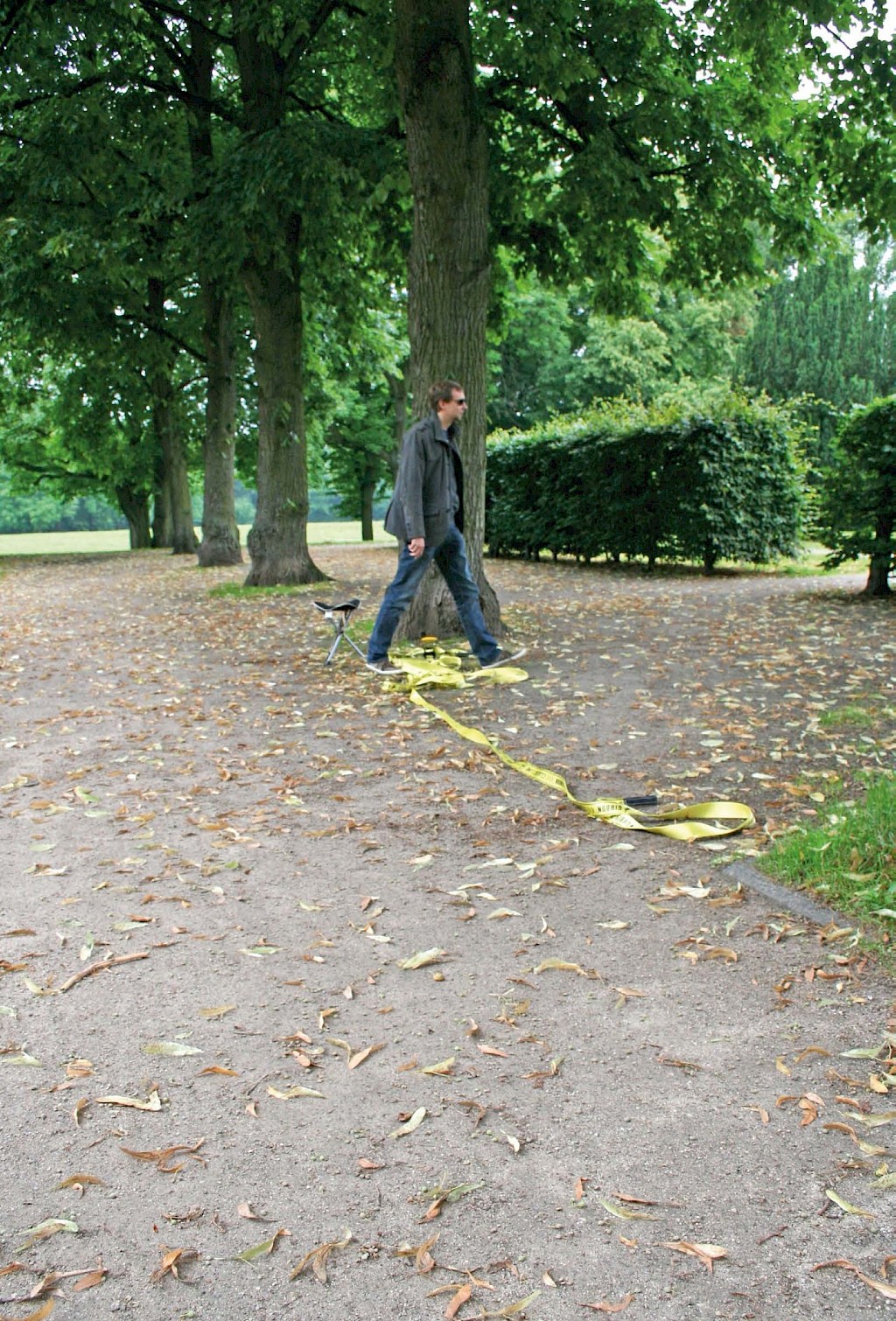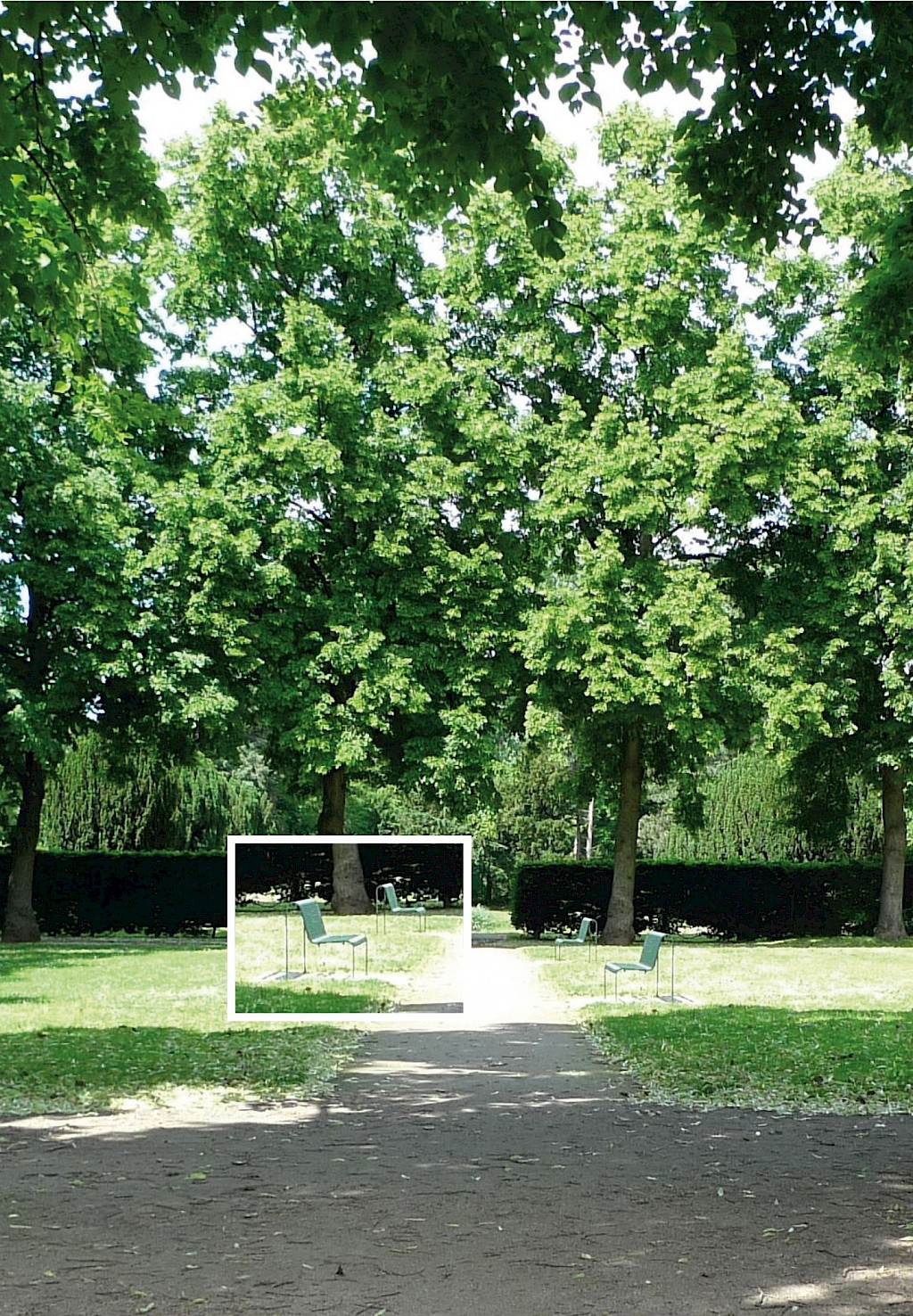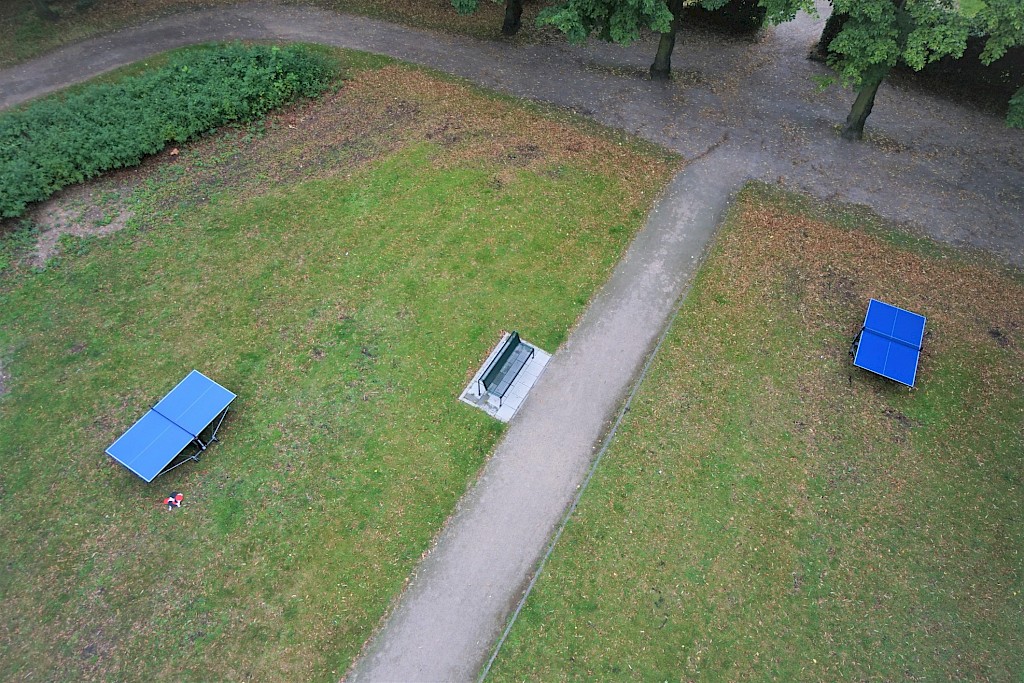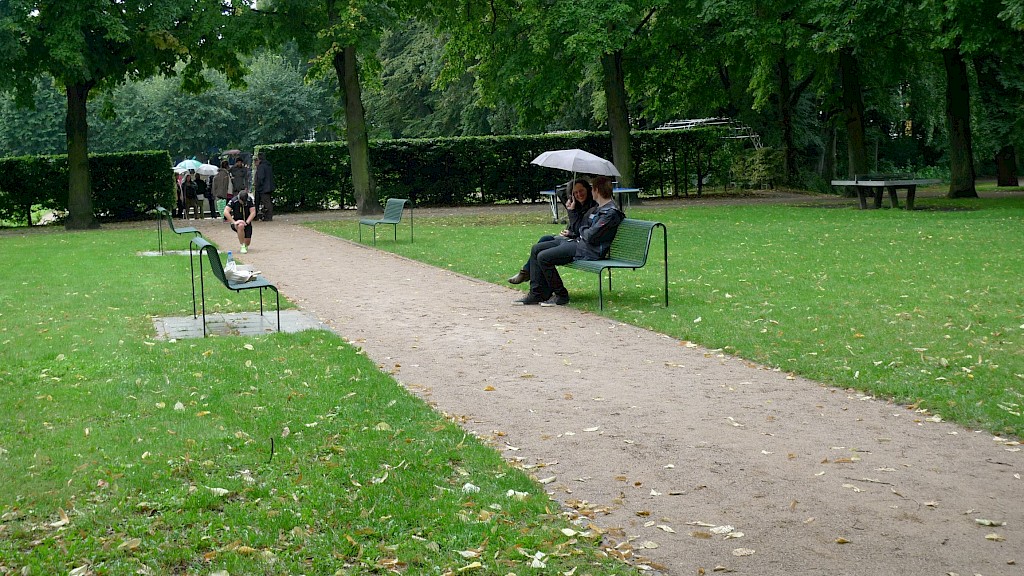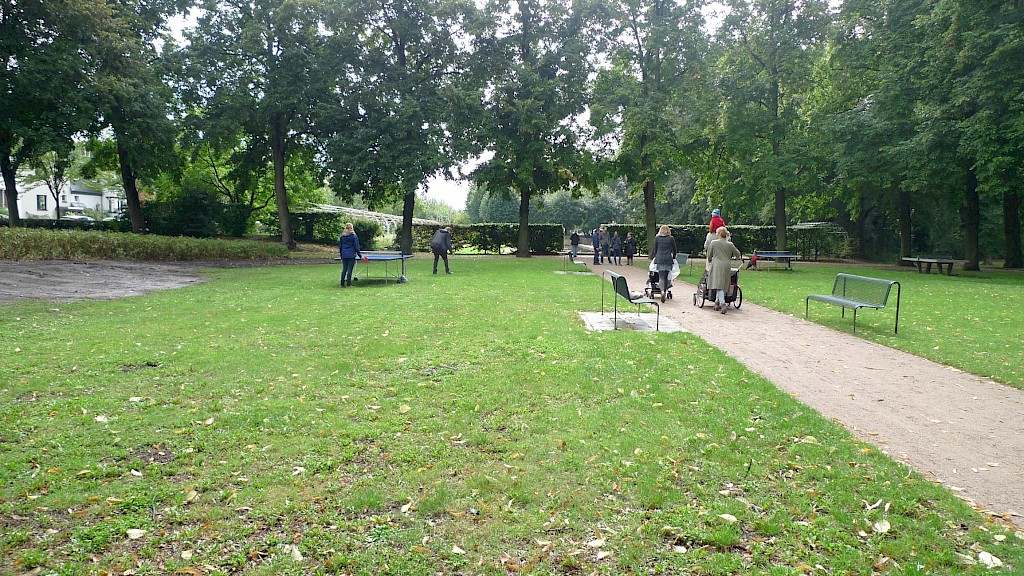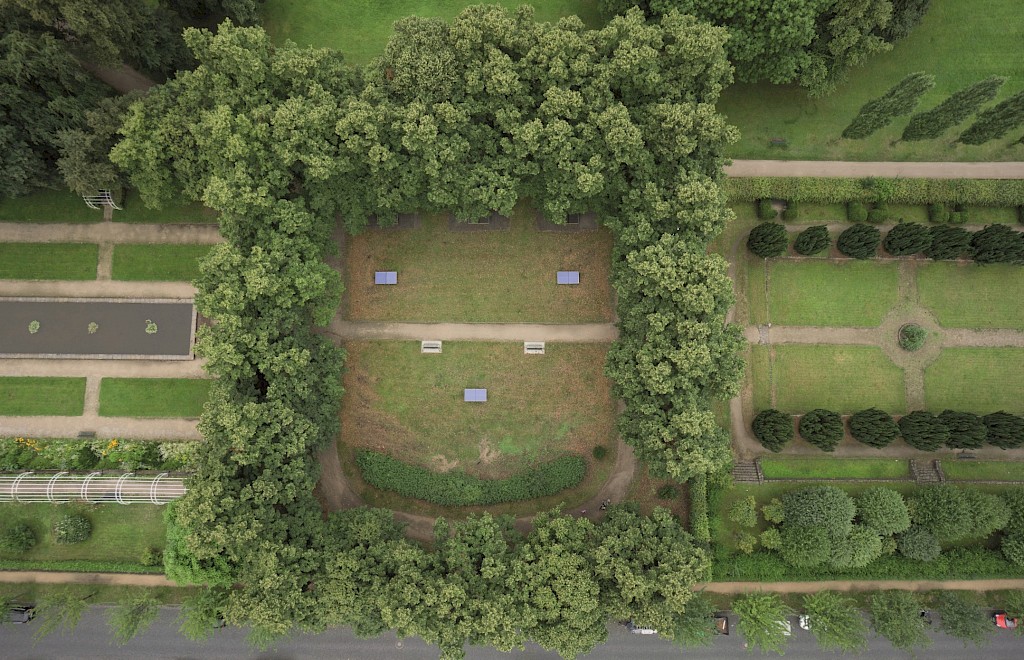Rules of the Game
2014, 3 mobile outdoor-table tennis table 2 park benches 6 games sets 1 slackline 1 TriPOD stool 1 student of sociology. Vorgebirgspark, Cologne
Werner Haypeter: „Rules of the Game“
Anyone who just happens to come upon Werner Haypeter‘s installation „Rules of the Game“ in the Baumhof courtyard of trees at the Cologne Vorgebirgspark will most likely not think of art at all. But this would be a great chance to get to know it. For one day only, three brand-new, portable outdoor ping pong tables in bright blue will stand alongside three permanently installed ones made of concrete, a little worse for wear from the wind and weather. The balls and paddles lie there ready for use. It almost seems like a ping-pong tournament might be about to begin. But why the unusual set-up of the tables, the one‘s position shifted so as to be placed across the footpath? And what is the yellow rope all about, which has been loosely placed on the ground between two trees on the northern side? Younger visitors to the park in particular will be quick to identify it as a slackline. This is a piece of synthetic webbing 15 meters long, which may be stretched between two trees, i.e. it can adapt to the distance between the trees, so that one may balance on it. The fact that the slackline lies unused on the ground, however, requires just as much explanation as does the fact that next to it a young man sits on a stool, watching like a museum guard. In answer to questions about perhaps using the slackline, he cites Cologne city ordinance § 24 (2) that applies here: „Slacklining and similar such types of sports which damage trees are permitted only in areas specially designated for this“. The Vorgebirgspark is not one of these specially designated areas.
The young man, who is happy to speak with the park visitors, is part of the installation. The fact that he is a sociology student is wholly in keeping with the artist’s concept. Haypeter’s work consists namely in inserting his precise formal artistic placements into existing social structures, thereby changing these. A social given that the artist can engage with is the concept of the game and the rule of the game. His installation does not start with the notion of “art”, but rather with the everyday knowledge, experience and imagination that park visitors bring with them, among other things, with respect to ping pong and slacklining. By pointing out the Cologne city ordinance, a further, overriding social rule enters into the game. But it is especially the park itself, its idea and its formal structure, which provides the stipulations Haypeter takes up and makes the departure point of his installation. In 1911, the garden architect Fritz Encke designed the Vorgebirgspark not lastly for those who, due to their living situation, do not have a garden of their own, or any other piece of green they can use, whereby the relaxation and recreational values of sports and games figure significantly here. Haypeter takes up this idea with his use of contemporary sports equipment, placing these in a relationship to the given spatial structures in the park.
The park’s predominant formal element is its symmetrical axis that runs like a spine through the four special gardens lined up in succession. In setting up the outdoor-ping pong tables, Haypeter incorporates this structure, though he carefully breaks up the symmetry. Their placement is oriented to three preexisting concrete tables in the park. The new tables divide their distance to the border of the axial path precisely in the middle. But although the middle ping pong table has also been set up at the same distance, this has been measured from the other side of the path, with the effect that a more open situation results overall. The ping pong tables become the material used for formally emphasizing the situation of the park, even as they make it possible to experience its spatial structures in a new way. At the same time, they are there so that the visitors to the park may use them to play ping pong. The artist himself underlines that he uses the tables like a painter uses color on canvas. And in this connection: the fact that Werner Haypeter has chosen blue ping pong tables and a yellow slackline is no coincidence, but a reference to the prevailing color of green in the park (at least in the summer). It is well known that mixing blue and yellow optically results in green.
Regarding the spatial criteria, the slackline also takes on a new significance. In principle, a slackline is designed for being spanned between two trees. Thus, like an abstract measuring tape, it points to the given distances between the lime trees bordering the Baumhof area to all sides, and thus constitutes an essential component of its overall spatial structure. A further formal placement is the product of Haypeter’s negotiations with the Cologne Parks Department with respect to permanently supplementing the two green wire mesh benches standing in the middle of the Baumhof with two further benches placed exactly opposite in order to reestablish the symmetry and create a communication-friendly situation.
This step alone proves that Haypeter’s installation will not simply end in its presentation on August 31, 2014. For him, the project has been conceived in much broader dimensions, comprising all steps of the planning, processes, and courses of action involved in its realization, and likewise the persons and institutions who played a role. This becomes clear with the portable ping pong tables in particular. These are not only portable in the most obvious sense that they are easily set up and taken down and, because they have four wheels, may be transported easily. They are also mobile in a systemic and logistic sense. For their acquisition, Haypeter found a sponsor, aptly a Bonn housing company, this fact consciously relating the installation to Fritz Encke’s idea behind conceiving the Volkspark as an expansion of urban living. Ordering the tables, setting them up, temporarily storing them in the Art School for Young People located immediately adjacent to the park, and setting everything up in the Baumhof (the space-structuring aspects of the installation being clearly illustrated in an aerial photograph made by a drone)– each of these individual steps (and many more) is a part of the work of art. Also important is the use of the ping pong tables for when the installation in the park has ended. They are to be given as gifts to three civic youth facilities in Cologne and Bonn. In this way they will move from the context of art, in which they found themselves temporarily, back again to another social relationship.
[Text: Peter Lodermeyer]
